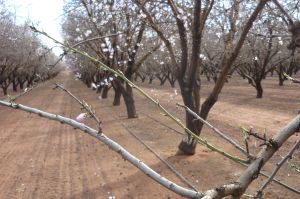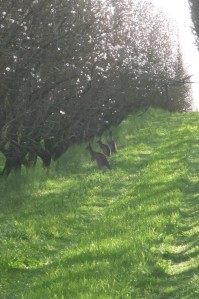Wild pollinator insects, especially bees, like diversity in their life. It’s not that they’re fussy, they just like to have different resources for nesting and foraging to choose from – just like us. This diversity in resources is important because wild pollinator communities aren’t just made up of bees, they include multiple species. We’ve (almost) figured out what honeybees like, and it’s easy to accommodate one species when you know the ins and outs of their biology. But ‘wild pollinators’ could mean solitary bees, bumblebees, huge hairy flies, delicate wasps, tiny midges, thrips, beetles, bugs, weevils, moths or butterflies. Some of these insects, particularly wasps and flies, may also control outbreaks of herbivorous insects, so they can provide multiple ecosystem services.
Suffice to say, we want them to hang around. So it’s important that management of agroecosystems considers the diverse requirements of this multitude of insects. It’s already established that wild pollinators can be found around farms when unmanaged native vegetation is nearby, and they also like farms that maintain flowering weedy patches around the margins or in headlands. However, most of the research that is available on wild pollinators has been done in Europe, North America or tropical regions. And coffee and canola seem to be the most popular study systems.
There is less knowledge of wild pollinators of tree nut crops in countries like Australia, where the trees are exotic species. This means that they have not co-evolved in a relationship with the native pollinator insects, like they have in their regions of origin. Many tree crops are pollinator-dependent, which means flowers need to be cross-pollinated with pollen from a flower on another tree, before they can set fruit. This is why the orchard industry is so reliant on managed honeybees, which is increasingly causing all sorts of stress to the bees.
I’ve just had a paper published online in the Journal of Insect Conservation with two of my PhD supervisors (Gary Luck & Margaret Mayfield), where we looked at potential wild pollinators in almond orchards in Australia. Australia is the second-biggest almond producer in the world, and we now produce more almonds than we do our native macadamia nut. The industry has grown so quickly, and much of the historical research on almond growing in Australia has been biological or economic in focus – cultivars, pollenizers, more nuts, more yields etc.
In this study, we sampled during the almond flowering season, and looked at whether ground cover in orchards is associated with more wild pollinators. Most conventional almond plantations are broadscale monocultures, covering huge tracts of land, with completely bare ground maintained throughout the orchard. We compared these plantations with smaller orchards (biodynamic and low-intensity conventional) that maintained living ground cover throughout the orchard, as well as the semi-arid mallee woodlands that are native to the region.

Although native mallee vegetation had higher species richness of pollinators, pollinators were more abundant in orchards with ground cover than in either mallee or the bare monoculture plantations. We looked at relationships between each different pollinator group (native bees, flies, wasps) and the percentage cover or richness of living ground cover, and found a few interesting things, including that bee species richness was associated much more strongly with plant richness than simply percent cover of the living ground cover. This agrees with lots of other studies that have found that non-Apis bees, like a lot of other animals, prefer heterogeneity over homogeneity.

Our study was a small-scale ‘snapshot-in-time’ study, and more detailed sampling will deliver more certainty on how growers could benefit from these insects. But it’s still given us important clues about what’s going in this system, and highlighted how simple little changes in management can produce huge benefits for the ecology, function, and therefore production, of a farm.
Ground cover doesn’t only look pretty, it can also improve soil quality and biological activity, and support more biological control agents. If it brings the pollinators too, what more could growers want!
© Manu Saunders 2013
I just have a big block with a mix of native and food plants, but it’s good to know the balance is healthy. Thanks for a very interesting post.
LikeLike
No worries. A mix of plants is good – I’m sure you’ve got heaps of helpful insects there too! 🙂
LikeLike
I live in Warrandyte and I’ve discovered insects I never knew existed. No idea if they’re pollinators or not but I guess the more the merrier. 🙂 I don’t use sprays so that helps too I think.
LikeLike
Definitely! no sprays are even better 🙂
LikeLike
Is is unPC to wish I could get rid of the mozzies?
LikeLiked by 1 person
Now I have a great excuse to leave the weeds growing between my veg beds. “It is for the bees” rather than “I’m too lazy”…. 😀
LikeLike
Nice! 🙂
LikeLike
It’s a great shame that most almond producers refuse to plant wildflowers between the trees, creating a desert where pollinators can’t live all year round.
LikeLike
I agree. I know the orchards look much more striking with bare ground, but that’s really not a good reason to get rid of all the plants!
LikeLike
Think the reason they do it is commercial – they don’t want the honeybees they hire to spend time pollinating anything other than almonds. But it’s backwards thinking as if they let other flowers grow they might not need to hire so many bees.
LikeLike
Yes, that’s probably a good point. In Australia, some growers do it because there is government extension material from a few decades back that advise growers to get rid of ground cover because it increases frost damage and competes for soil moisture with almond trees. I’m not sure how though, as the trees are deep-rooted and most grasses and wildflowers are shallow-rooted…but I’m not a soil scientist. 🙂 Also, it’s apparently a pain during harvesting – because the nuts are shaken off the trees onto the ground where they need to dry, and grass doesn’t let them dry. But the small orchards I studied that have ground cover, just collect all the nuts up and take them to another part of the farm where there is an area of bare compact soil especially for nut drying – it’s more labour intensive, but it works just fine!
LikeLike
Interesting about drying out the nuts, thanks for the info!
LikeLike
Congratulations on getting your paper published.
I’m shocked that any grower would value so much bare soil – surely there are significant issues with erosion? In France, their walnut orchards tend to be vegetated, despite the fact that the tress cast dense shade and produce jugulone. Actually, the French landscape in the main walnut-growing areas is very diverse and tends to include an abundance of native species… clearly a good thing.
LikeLike
Thank you! Yes, I am quite surprised that this practice is maintained. I’ve only been looking at the insect/habitat side of the system, but I’m sure there are lots of complex economic factors involved in the decision. 😉 I agree, a lot of traditional-style European orchards do maintain ground cover, although some of the larger olive monocultures in Spain have bare ground, and as you say, they do have big problems with erosion. Hopefully Australian agriculture will get inspired by the traditional European model of farming, rather than the American ‘dustbowl’ model!
LikeLike
I guess that access for machinery is a key consideration in big commercial systems. Do you have organic producers? And if so, what are their systems like?
LikeLike
Yes, some of the orchards with ground cover that I sampled were biodynamic, which is basically a holistic type of organic ag. Their owner was managing them for commercial production, and has been for years. Another ground cover orchard I sampled was a small ‘low-intensity’ one and had a strip of ground cover up the middle of the row, but bare soil around the tree trunks. I think there are plantations in South Australia that do this too, so it is possible to produce almonds on a commercial scale with ground cover in the orchard, it just takes a bit more effort. Also see my reply to Emily above about harvesting.
LikeLike
Your post has inspired my post today – thank you!
LikeLike
Well done on your publication, and thanks for a super interesting post here. It’s always fascinating to see how quickly industrial processes (like bare soil orchards) become canon, and how once they are implemented, how loathe people are to return to tried and true methods.
I imagine the tidy bare soil approach also requires herbicides, no?
LikeLike
Thanks! Yes many bare ground orchards use herbicide to control weeds. The ones I sampled used fairly ‘low-intensity’ herbicides as needed (i.e. not on a frequent, regular schedule), and didn’t use any pesticides or insecticides…so I guess that’s better than some other cropping systems!
LikeLike